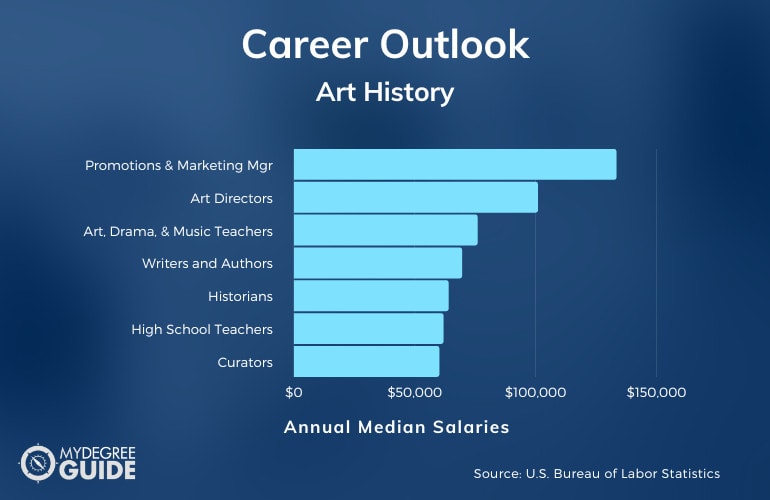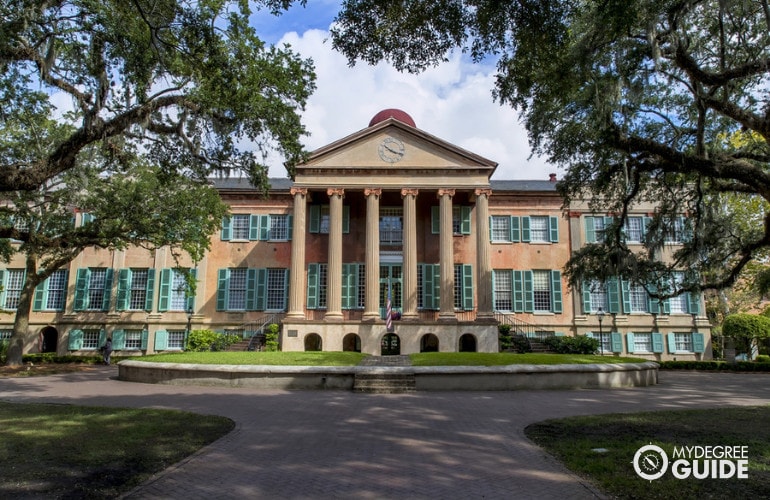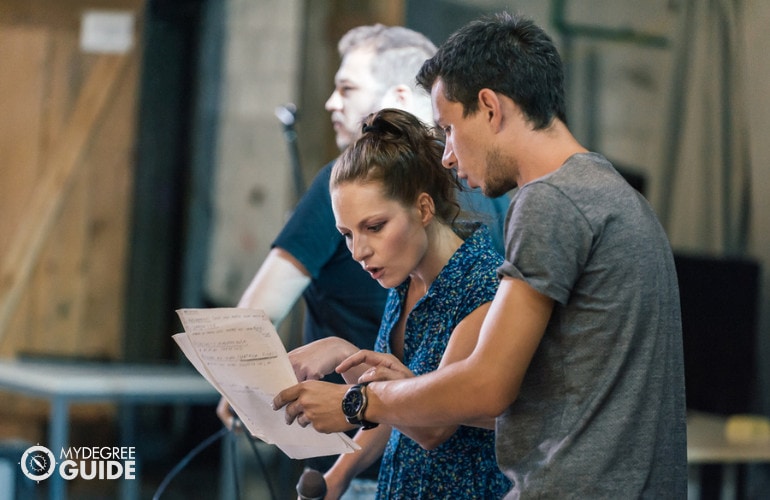An online art history masters degree can deepen your understanding of and appreciation for the visual arts.

You can explore how art varies in different cultures, how art has changed throughout history, and how art communicates the thinking of its time and culture.
Editorial Listing ShortCode:
If you want to work or already work as any kind of artist or art educator, this advanced knowledge could be quite valuable. Keep reading to learn more about pursuing an art history master’s degree.
Universities Offering Online Masters in Art History Degree Programs
Methodology: The following school list is in alphabetical order. To be included, a college or university must be regionally accredited and offer degree programs online or in a hybrid format.
Academy of Art University
The Academy of Art University offers a Master of Arts in Art History. Classes are 7.5 or 15 weeks long and offered online. Students must complete 36 credit hours with a minimum GPA of 2.0 and a final thesis project to graduate. Applicants must have a bachelor’s in art history to be eligible.
Academy of Art University accredited by WASC Senior College and University Commission.
Azusa Pacific University
Azusa Pacific University offers a Master of Arts in Modern and Contemporary Art History. To graduate, students must complete 36 credit hours. All classes can be taken online and are 8 weeks long. Applicants may apply online through the school’s website with two letters of recommendation, a statement of purpose, and official transcripts.
Azusa Pacific University is accredited by the WASC Senior College and University Commission.
Eastern Illinois University
Eastern Illinois University offers a Master of Arts in Art Education. The program is offered in a part-time, online format and is designed for those interested in becoming teachers. Students must complete 33 credit hours to graduate. Applicants must have a bachelor’s degree with a minimum GPA of 2.75 and three letters of recommendation.
Eastern Illinois University is accredited by the Higher Learning Commission.
Fort Hays State University
Fort Hays State University offers a Master of Liberal Studies with a concentration in Art History. Students must complete 31 credit hours to graduate. Those interested in the program must have a bachelor’s in art history with a GPA of 3.0 or higher and a current resume.
FHSU is accredited by the Higher Learning Commission.
George Washington University
George Washington University offers a Master of Arts in Art History. To graduate, students must complete 36 credit hours and a final capstone project. Interested applicants must submit two letters of recommendation, official transcripts, a statement of purpose, and a recent writing sample with their application.
George Washington University is accredited by the Middle States Association of Colleges and Schools.
Lindenwood University
Lindenwood University offers a Master of Arts in Art History and Visual Culture. The program can be completed online. Students must complete 30 credit hours to graduate. Those interested in the program may apply online through the school’s website. Copies of all previous transcripts must be submitted when applying.
Lindenwood University is accredited by the Higher Learning Commission.
Northwestern State University of Louisiana
Northwestern State University of Louisiana offers a Master of Arts in Art the Study of Fine and Graphic Arts. Of the 33 credits that are required, 27 may be completed online. Applicants may apply online with copies of their college transcripts, GRE scores, and two letters of recommendation.
Northwestern State University of Louisiana is accredited by the Southern Association of Colleges and Schools Commission on Colleges.
University of Florida
The University of Florida offers a Master of Arts in Art Education. The program is offered online, and classes are 8 weeks long. Students must complete 36 credit hours to graduate. Applicants must have a GPA of 3.0 or higher from a bachelor’s program in an art field, three letters of recommendation, and an art portfolio.
The University of Florida is accredited by the Southern Association of Colleges and Schools Commission on Colleges.
University of Nebraska – Kearney
The University of Nebraska—Kearney offers an online program for a Master of Arts in Education with a focus on Art. An emphasis in Classroom Education or Museum Education may be added. Students must complete 36 credit hours to graduate. To be eligible for the program, applicants must have a bachelor’s degree related to the field.
UNK is accredited by the Higher Learning Commission.
University of Northern Iowa
The University of Northern Iowa offers a Master of Arts in Art Education. Students must complete 30 credit hours over the course of five semesters to graduate. To be eligible for the program, applicants must submit an online application through the school’s website along with copies of their official transcripts.
The University of Northern Iowa is accredited by the Higher Learning Commission.
Online Art History Masters Degree Programs

Art history masters programs online teach about different eras in art history, such as the baroque period and the neoclassicist period. They also explore how art has changed throughout history in terms of both tools and techniques.
In addition, you’ll often study the relationship between art and various social and political movements, including how these movements influenced art at the time and how art influenced these movements. Art history typically includes the study of how art varies in different cultures and regions, such as Europe, Africa, or Asia.
An MA in Art History online program usually covers subjects such as:
- Renaissance art
- Modern art
- Impressionism
- Photography
- Art criticism
Because the study of art history is international in scope, foreign language study is also a common requirement. Some universities even offer study abroad opportunities for art history grad school students. Art history masters programs generally require the completion of a thesis or a research paper.
Online art history graduate programs tend to offer various formats. Some use an asynchronous model, in which you pace yourself through your coursework. Others provide more structured courses with set online meeting times, and some online grad programs follow a cohort model.
Advanced education in art history can help you qualify for museum archivist or curator positions. Some junior colleges even allow those with a masters to teach. There are also many professional artists and art educators who earn an art history masters to expand their knowledge and qualifications.
Art History Careers & Salaries

Once you have earned your online masters in art history, possible fields in which you could work include arts and design, education, or media and communication. According to the Bureau of Labor Statistics, here are some careers related to art history, accompanied by their median annual salaries.
| Careers | Annual Median Salaries |
| Advertising, Promotions, and Marketing Managers | $133,380 |
| Art Directors | $100,890 |
| Art, Drama, and Music Teachers, Postsecondary | $75,940 |
| Writers and Authors | $69,510 |
| Historians | $63,940 |
| High School Teachers | $61,820 |
| Curators | $60,110 |
| Archivists | $60,050 |
| Set and Exhibit Designers |
$54,860 |
| Museum Technicians and Conservators | $47,630 |
Art history graduates tend to pursue careers working for schools, libraries, museums, or similar settings, often using their knowledge to educate others. With a master’s degree in art history, you can be better prepared to both create art and to help others understand art.
Art History Master’s Curriculum & Courses

Here are examples of courses you might take while earning your master’s degree in art history:
- Approaches to Art: In this course, you’ll learn about different methods for analyzing art.
- Art Theory and Criticism: In this course, you’ll learn to interpret art and to look for symbolic meanings.
- Research and Scholarly Writing: This course helps prepare you to write your thesis, and it teaches you how to conduct historical research using primary and secondary sources.
- Italian Art: In this course, you’ll study the works of great Italian artists and learn about the historical influence of Italian artists.
- Nineteenth Century Art: In this course, you’ll learn about Western art from 1800 through 1899.
- Impressionism: In this course, you’ll learn about painters of the Impressionist period within the nineteenth century, such as Monet and Degas, and you’ll learn about the lasting influence of Impressionist painters on modern art.
- Twentieth Century Art: In this course, you’ll learn about Western art from 1900 through 1999.
- History of Photography: In this course, you’ll learn about how the art of photography has changed over time, from the camera’s invention to present day.
- Modern and Contemporary Art in Asia: In this course, you’ll study the works of prominent Asian artists, and you’ll learn about current movements in Asian art.
- New Media: In this course, you’ll learn about digital art and storytelling and about how modern technology and the Internet can be applied in art.
Exact course titles and requirements will vary at different universities. Your coursework can also be influenced by a degree concentration.
How to Choose an Online Art History Grad Program

There are many factors to consider when deciding which art history grad program is right for you. Here are some items to think about:
- How much structure do you want? You might prefer an online program with set meeting times, or you might want the freedom to pace yourself and work entirely on your own schedule.
- How much are you willing to pay? Some programs charge higher tuition than others, and each school can vary in how much financial aid is available.
- Do you want a specific concentration? Some programs offer degree concentrations, which can allow you to pursue specialized interests.
You can explore the various program options available to find which type of program matches your personal needs and preferences.
M.A. in Art History Admissions Requirements

Here are some common admissions requirements for Master of Arts in Art History programs:
- Accredited bachelor’s degree, preferably in art or a related field
- Minimum GPA of 3.0, on average
- Letter of intent
- Personal recommendations
Some programs require additional criteria, such as an interview or the submission of a portfolio. While some schools still ask for GRE or GMAT scores, a growing number of schools are no longer requiring this.
Accreditation

In the regional accreditation process, a college or university is regularly evaluated based on the quality of its academic programs and student services. The status of regional accreditation verifies that a degree program meets certain objective standards.
Attending an accredited school can make it easier to obtain financial aid or transfer to a different school or program. You can usually find out if a college or university has received regional accreditation by visiting its website.
You can also learn more about regional accreditation by visiting the Council for Higher Education Accreditation (CHEA).
Financial Aid and Scholarships

If you are intending to go to graduate school, you might be concerned about the cost. Luckily, there are many financial aid options available to help make a graduate education more affordable for qualifying students.
You can see if you’re eligible for state or federal aid, for grants or scholarships from your university, or for an employer program. Some art history organizations offer scholarships as well. For many students, the first step to determining eligibility for need-based aid is to fill out the Free Application for Federal Student Aid (FAFSA).
What Can You Do with a Masters in Art History?

Some of the most relevant career paths for art history masters graduates include art director, archivist, curator, museum worker, or community college teacher.
You could also consider teaching at the K-12 level, either by teaching at a private school or becoming licensed to teach in a public school. Knowledge of art history can even be applied in fields like advertising and marketing, as they require an understanding of how visual images convey messages.
Can I Get a Masters in Art History Online?
Yes, you can earn a masters degree in art history online. Many schools utilize online platforms that allow you to interact with classmates and instructors while studying art history.
Some online degree programs expect you to make occasional trips to campus for intensives and other activities, while others are completely online. Online programs are known for their convenience and flexibility, and they eliminate the need to commute to campus. Online learning can be especially helpful for students who are working while attending school.
How Long Does It Take to Get an Art History Masters Online?

A typical masters degree program in art history takes 1 to 2 years to complete with full-time study. If a program consists of 36 credit hours of coursework, it can often be completed in 1 year of full-time enrollment, including during the summer term.
You may need more time to finish if your program requires you to complete a thesis. Depending on how many credit hours of coursework they take each semester, part-time students usually take longer to finish as well.
What’s the Difference Between an MA vs. MFA in Art History?
You can earn either a Master of Arts (MA) or a Master of Fine Arts (MFA) in Art History. Here are some key differences between these two types of degree programs.
| MA in Art History | MFA in Art History |
|
|
There is some overlap in what you would study in either type of program.
Is a Masters in Art History Worth It?
Yes, a masters in art history is worth it for many students. Art history is a fascinating subject, and it’s a passion for many people. While art history can be a competitive field, the job outlook for the next decade is quite positive.
The Bureau of Labor Statistics currently projects that the employment of archivists, curators, and museum workers will grow by 19% in that timeframe. Meanwhile, art directors are expected to see 11% job growth, and postsecondary teachers are expected to see 12% job growth.
Getting Your Masters Degree in Art History Online

Maybe you’ve decided that earning a masters degree in art history is the next step in your education and career. Earning your masters can enable you to pursue more job opportunities as well as spend time studying something you love.
There are many online options available for studying art history at the graduate level. An online art history degree program could be especially beneficial if you are trying to balance school with work, family, or other commitments.
Some online degree programs, including online art history associates degree, bachelors degree, and masters degree programs, even offer multiple start dates each year, so you can start almost any time. Why not take the next step in your educational journey today by exploring accredited universities?
